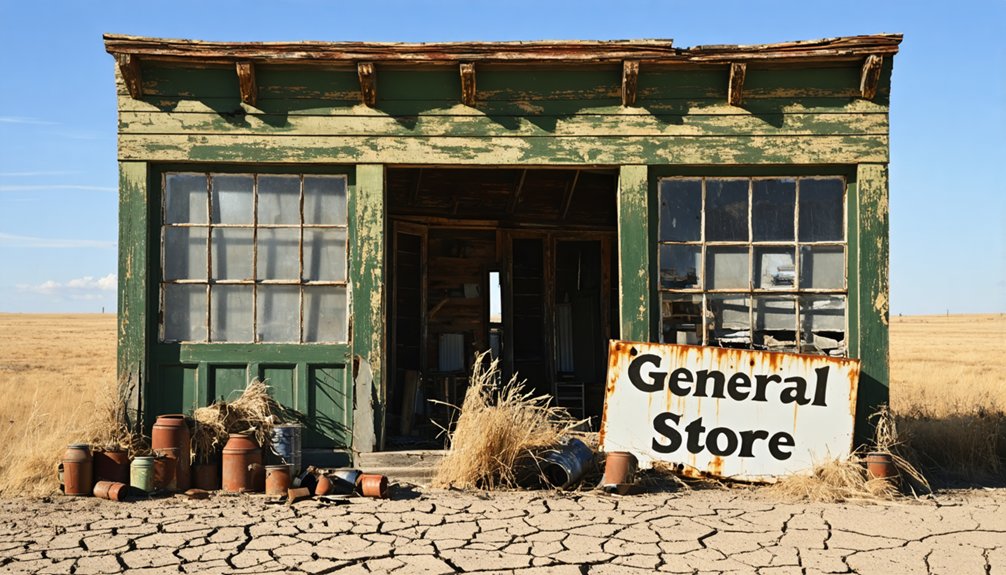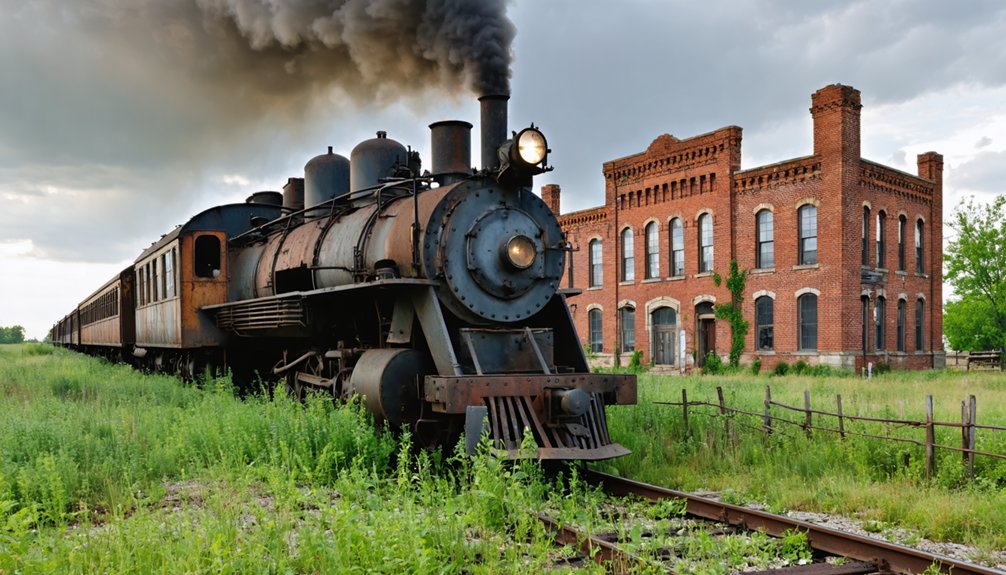You’ll find Ardmore, South Dakota along the old Burlington Railroad line, where a bustling frontier town once thrived after its 1889 establishment. The settlement served as an essential water stop for steam locomotives until environmental challenges, including toxic creek water and persistent drought, forced residents to abandon their dreams. Today, weathered structures and an iconic water tower stand guard over empty streets, telling tales of western expansion’s harsh realities and untold frontier stories.
Key Takeaways
- Ardmore was established in 1889 by Burlington Railroad as a strategic refueling point but is now an abandoned ghost town.
- Toxic pollution and highly acidic waters from Hat Creek made the water supply non-drinkable, contributing to the town’s abandonment.
- Mining operations dumped 2,700 tons of toxic sediments daily into Whitewood Creek between 1900-1978, creating severe environmental hazards.
- Persistent drought conditions and failed agricultural attempts, including experimental dry farming, made sustainable living impossible.
- Today, deteriorating 19th-century architecture and a restricted-access water tower remain as remnants of this former frontier settlement.
The Birth of a Frontier Settlement (1889)
When the Burlington Railroad sought a strategic refueling point near the Nebraska border in 1889, Ardmore, South Dakota emerged as a frontier settlement full of promise.
You’d find European-American pioneers drawn to this classic frontier town, enthusiastic to stake their claim in the expanding American West. Despite high hopes for its role in regional rail transport, settlement challenges emerged almost immediately. Early homesteaders like Dennis and Elizabeth O’Connell were among the first to establish roots in the developing community.
The town’s location, while ideal for railroad operations, revealed harsh environmental realities that would shape its destiny. You’ll recognize the era’s pioneering spirit in the railroad impact on Ardmore’s design – frontier-style buildings centered around the rail stop showcased the determination of early settlers to forge a new community, even as they grappled with the unforgiving landscape of their chosen home. The settlers attempted experimental dry farming techniques, but these efforts ultimately failed to produce sustainable crops for the community.
Life Along the New Burlington Railroad
If you’d visited Ardmore in its early days, you would’ve found a bustling railroad stop where steam engines regularly halted to replenish their water supplies from the town’s strategic water tanks.
You would’ve witnessed how this crucial water stop function helped Ardmore grow from a simple railway checkpoint into a proper settlement, as railroad workers, merchants, and settlers established homes and businesses near the tracks.
The steady stream of trains brought energy to the town, with each steam engine’s whistle marking the rhythm of daily life and the promise of new opportunities along the Burlington line.
The town’s development mirrored many other settlements that emerged after the Chicago, Burlington and Quincy Railroad began expanding across northern Wyoming and nearby territories in the 1890s.
The railroad’s importance only grew when it became part of the Burlington Northern merger in 1970, creating the largest rail network in America at that time.
Steam Engine Water Stops
Steam locomotives, the mighty workhorses of early American railroads, required frequent water stops every 7 to 10 miles along their routes to maintain their critical boiler operations.
You’d find essential water stop infrastructure dotting the rail lines, featuring towering water tanks and mechanical cranes that swung over the tracks to quench the thirsty engines. Each stop became a hub of activity, where crews managed locomotive water needs while tending to maintenance and refueling duties. The Worthington SA feedwater heaters helped optimize water consumption and boiler efficiency on many locomotives.
These strategic points often sparked the growth of small communities, providing services to railroad workers and passengers alike. Much like Chicago’s emergence as a crucial continental divide connecting the Mississippi River and Great Lakes watersheds, these water stops became vital links in America’s expanding rail network.
You can still spot remnants of these stops today, some transformed into ghost towns after diesel engines made them obsolete. The water towers and maintenance sheds stand as silent sentinels, reminding us of steam railroading’s golden age.
Railroad Settlement Growth
As the Burlington Route pushed northward from Alliance, Nebraska, in 1888, a remarkable transformation began reshaping the American frontier. You’d have witnessed a surge of new settlements springing up alongside the tracks, as the railroad’s influence carved paths through untamed territories.
Towns like Ardmore emerged where steam engines stopped, quickly growing into vibrant communities with stores, housing, and essential services. The railroad’s diverse cargo of agricultural products supported these growing frontier towns.
The railroad’s steady march brought waves of workers who established temporary camps that often evolved into permanent settlements. You’d have found a mix of skilled railroaders laying track and operating locomotives, alongside laborers driving spikes and placing ties. These railroad towns became crucial stops along the extensive network that would later become part of the Burlington Northern Railroad in 1970.
These communities fostered a unique social environment where life revolved around the rhythm of passing trains, creating gathering places that turned strangers into neighbors.
Water Woes and Environmental Hardships
You’ll find that Ardmore’s biggest enemy was its water supply – a highly acidic creek that proved toxic for drinking and a persistent drought that devastated local farming efforts.
The town’s residents struggled to maintain viable agriculture despite government-sponsored dry farming experiments, while steam engines required constant exchanges of the dangerous creek water for clean water from elsewhere. During a notable attempt to address farming challenges, President Calvin Coolidge visited an experimental farm in the area to assess potential solutions.
As environmental hardships mounted and water problems went unsolved, the town’s future grew increasingly uncertain, with both railroad operations and local farming fighting a losing battle against nature’s constraints. The transition from steam powered trains ultimately reduced the need for water stops in Ardmore, further accelerating its decline.
Toxic Creek Challenges Lives
While mining operations brought prosperity to some South Dakota towns, they left a devastating environmental legacy in Ardmore through Whitewood Creek’s severe contamination.
You’d find roughly 2,700 tons of mining sediments dumped daily into the creek between 1900 and 1978, creating toxic pollution that still haunts the region today. The water you’d encounter carries dangerous levels of arsenic, mercury, and other heavy metals that have traveled hundreds of miles downstream.
The health risks weren’t limited to Ardmore’s residents – they’ve spread throughout the Belle Fourche, Cheyenne, and Missouri Rivers, affecting wildlife and communities along the way.
The acidic, metal-laden waters from Hat Creek became so hazardous that they weren’t even drinkable, contributing to Ardmore’s eventual abandonment as a livable town.
Drought Devastates Local Agriculture
The devastating drought conditions that struck South Dakota in late summer 2024 brought Ardmore’s agricultural economy to its knees, leaving parched soil and withered crops in their wake.
You’ll find that the drought impact extended far beyond failed harvests, as the lack of winter snow and spring rainfall created a devastating cycle of agricultural decline. With only a 23% chance of above-average spring precipitation, farmers watched helplessly as their dreams withered alongside their crops.
Without sufficient moisture for dry farming or proper irrigation infrastructure, you can understand why Ardmore’s residents eventually surrendered to nature’s harsh reality.
The town’s fate was sealed as livestock struggled to survive on depleted pastures, and both soil health and water quality deteriorated, ultimately forcing families to abandon their homesteads.
Failed Water Supply Solutions
Despite numerous attempts to secure a reliable water supply, Ardmore faced insurmountable challenges due to Hat Creek’s highly acidic waters and insufficient infrastructure development.
You would’ve seen no water towers, reservoirs, or treatment facilities in Ardmore – critical water infrastructure that neighboring towns had successfully built to guarantee their survival.
While steam trains briefly found use for the acidic creek water, you couldn’t drink it or use it for farming.
The town’s desperate attempt at dry farming proved futile against persistent drought conditions and poor soil moisture.
Without investment in alternative water sources or proper storage systems, agricultural viability plummeted.
As trains modernized and abandoned steam power, even Hat Creek’s limited industrial use vanished, leaving Ardmore with no sustainable water solution for its remaining residents.
Failed Dreams: The Government’s Dry Farming Project

In 1911, as agricultural expansion swept across America’s Great Plains, the United States government established a Dry-Land Field Station near Ardmore, South Dakota.
You’d have witnessed ambitious researchers breaking virgin prairie sod, planting test crops in 1912 as part of a broader vision to conquer the semi-arid plains through dry farming techniques.
Presidential Visit and Glory Days
During Ardmore’s peak as a bustling railroad hub, President Calvin Coolidge’s visit for a picnic marked a crucial moment in the town’s history.
You’ll find this presidential impact particularly significant as it came during South Dakota’s push to revitalize its struggling economy through tourism. Coolidge’s presence helped spotlight Ardmore and the Black Hills region on the national stage.
The town’s strategic location near the Nebraska border made it an essential commercial center, where trains regularly stopped for both passengers and freight.
The tourism boost from Coolidge’s visit led to improved infrastructure and roads for automobile travelers.
While Ardmore would later face decline due to drought and poor water quality, this golden era showcased its importance in the region’s transportation network.
The Last Stop for Steam Engines

While steam locomotives thundered across America’s railways, Ardmore served as an essential refueling stop on the New Burlington Railroad line since its establishment in 1889.
You’ll find the town’s railroad history intertwined with steam technology, as it provided a vital last-stop service for water-hungry locomotives before they entered more challenging terrain.
The town’s strategic importance, however, faced two significant challenges.
First, the local water supply proved problematic – drought conditions and acidic creek water forced an unusual arrangement where trains exchanged their clean water for the town’s supply.
Then, as diesel engines revolutionized rail transport in the mid-20th century, Ardmore’s purpose vanished.
Without the need for regular water stops, the once-bustling railroad town gradually faded into obscurity, though some residents held on until the 1980s.
The Great Exodus: From Boom to Abandonment
The bustling promise of Ardmore’s early days began to unravel as environmental challenges collided with the town’s fragile existence. You’d have witnessed remarkable community resilience as residents battled persistent droughts and acidic water that made daily life increasingly difficult.
Despite their determination, including attempts at dry land farming, the environmental impact proved too severe for long-term survival.
When steam engines gave way to newer technologies, you would’ve seen Ardmore’s strategic importance fade. Without the railroad’s frequent stops, the town lost its economic lifeline.
Though the community had weathered the Great Depression without welfare aid, the combination of harsh natural conditions and diminishing railroad traffic proved insurmountable. Families gradually departed, seeking places with better resources, leaving behind only weathered structures as evidence of their frontier spirit.
Modern Ghost Town: A Time Capsule in the Plains

Standing as a haunting tribute to frontier ambition, Ardmore’s weathered structures now dot the barren South Dakota plains along Highway 71.
You’ll find classic 19th-century architecture preservation efforts evident in the remaining brick buildings, though many have succumbed to time’s relentless march. “No Trespassing” signs and barbed wire fencing guard deteriorating landmarks like the iconic water tower, protecting them from further vandalism.
For historical photography enthusiasts, these architectural remnants offer a rare glimpse into frontier life, frozen in time.
Broken windows and rotted floors tell stories of abandonment, while the surrounding drought-stricken landscape reminds you why this railroad town couldn’t survive.
Today, Ardmore stands isolated amid the plains, a silent monument to the harsh realities that shaped America’s western expansion.
Frequently Asked Questions
Are There Any Paranormal or Ghost Sightings Reported in Ardmore?
You won’t find documented ghostly encounters in this location. While visitors might describe eerie experiences due to its desolate atmosphere, there aren’t any substantiated reports of paranormal activity.
What Happened to the Original Buildings and Homes of Former Residents?
You won’t find much “historical preservation” here – most buildings crumbled from neglect and weather. The brick corner store collapsed, the bank’s just a vault, and urban exploration’s limited by “No Trespassing” signs and barbed wire.
Is It Legal to Visit and Explore Ardmore Today?
You can’t legally explore without permission since it’s private property. Current ghost town regulations require exploration permits from landowners. You’ll risk trespassing charges if you venture past posted warnings and fences.
Who Owns the Abandoned Properties and Land in Ardmore Now?
Most buildings and land are privately owned by ranchers and individuals, with property rights enforced through “No Trespassing” signs and fencing. You’ll find land ownership split between local private landholders.
What Was the Peak Population of Ardmore During Its Most Prosperous Years?
In a time when every frontier town dreamed big, you’d find a modest peak population of 50-75 residents during historic milestones like Coolidge’s 1927 visit, before population decline stripped away the community’s energy.
References
- https://www.blackhillshikingbikingandmore.com/ardmore
- https://www.thetravel.com/south-dakota-ghost-town-ardmore/
- https://www.atlasobscura.com/places/ardmore-ghost-town
- https://www.youtube.com/watch?v=C95x3aqWN0g
- https://www.tripadvisor.com/ShowUserReviews-g28962-d1233709-r226494802-Ardmore-South_Dakota.html
- https://www.onlyinyourstate.com/experiences/south-dakota/ardmore-ghost-town-sd
- https://en.wikipedia.org/wiki/Ardmore
- https://www.postcard.inc/places/ardmore-south-dakota-2
- https://www.southdakotamagazine.com/ardmore
- https://www.wyohistory.org/encyclopedia/burlington-route-wyomings-second-transcontinental-railroad



